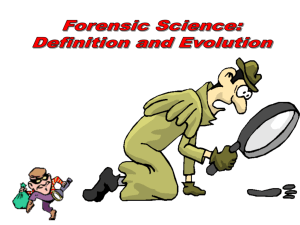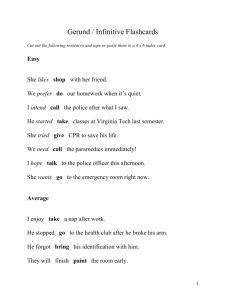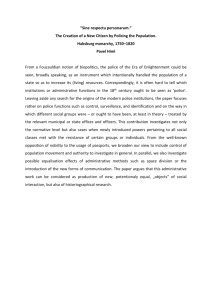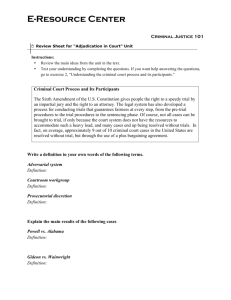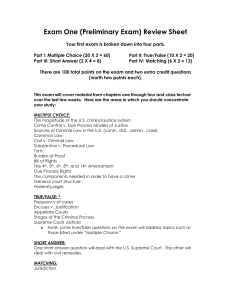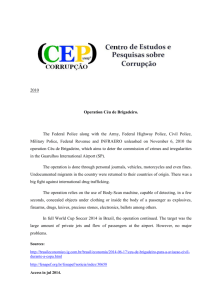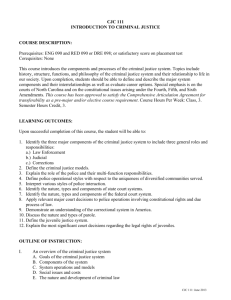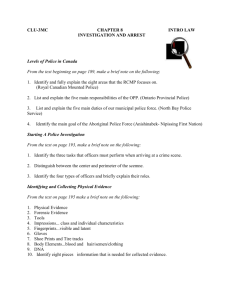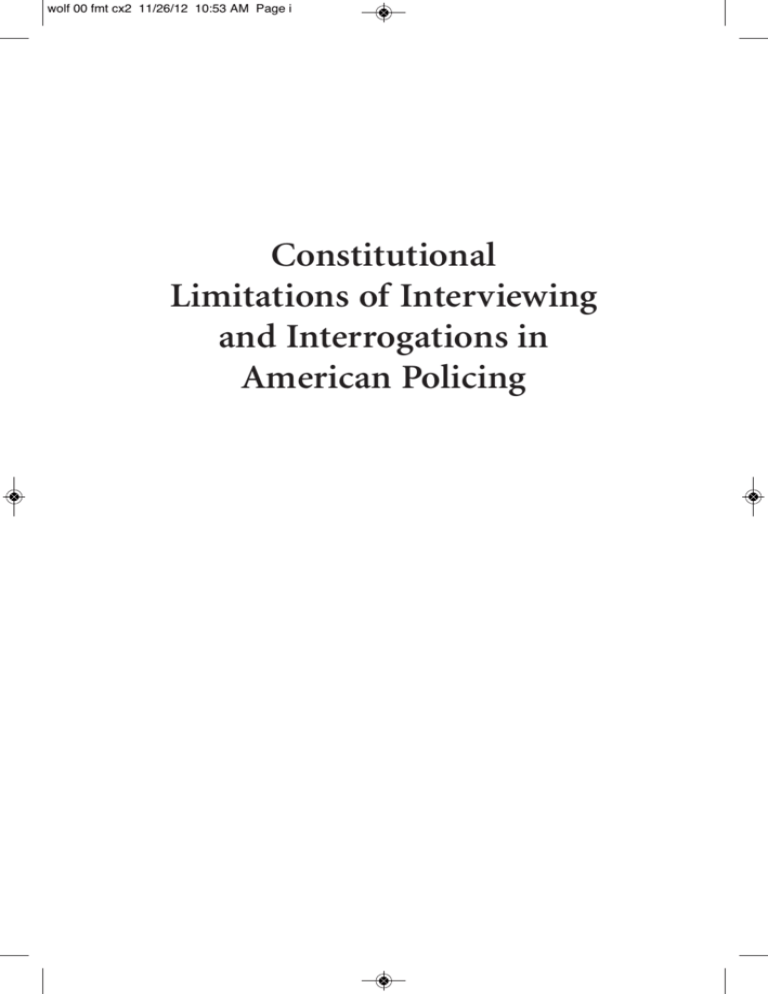
wolf 00 fmt cx2 11/26/12 10:53 AM Page i
Constitutional
Limitations of Interviewing
and Interrogations in
American Policing
wolf 00 fmt cx2 11/26/12 10:53 AM Page ii
wolf 00 fmt cx2 11/26/12 10:53 AM Page iii
Constitutional
Limitations of Interviewing
and Interrogations in
American Policing
Ross Wolf
Charles Mesloh
Robert H. Wood
Carolina Academic Press
Durham, North Carolina
wolf 00 fmt cx2 11/26/12 10:53 AM Page iv
Copyright © 2013
Carolina Academic Press
All Rights Reserved
Library of Congress Cataloging-in-Publication Data
Wolf, Ross.
Constitutional limitations of interviewing and interrogations in American
policing / Ross Wolf, Charles Mesloh, and Robert H. Wood.
p. cm.
Includes bibliographical references and index.
ISBN 978-1-61163-193-7 (alk. paper)
1. Police questioning--United States. 2. Interviewing in law enforcement-United States. 3. Criminal investigation--United States. 4. Confession (Law)-United States. 5. Right to counsel--United States. I. Mesloh, Charles. II.
Wood, Robert H. III. Title.
KF9625.W65 2013
342.7308'5--dc23
2012039144
Carolina Academic Press
700 Kent Street
Durham, North Carolina 27701
Telephone (919) 489-7486
Fax (919) 493-5668
www.cap-press.com
Printed in the United States of America
wolf 00 fmt cx2 11/26/12 10:53 AM Page v
Contents
Preface
xi
Chapter 1 • Introduction
The Criminal Court System
Categories of Crimes
Federal Courts
State Courts
Attorneys
The Court Case
Interview versus Interrogation
The Interview
The Interrogation
Admissibility
Plea Bargaining
Discussion
3
3
3
4
5
5
6
8
9
10
11
13
14
Chapter 2 • Landmark Cases
Confession Law Genesis and Development
Case Summary of Bram v. United States, 168 U.S. 532 (1897)
Discussion
Case Summary of Brown v. Mississippi, 297 U.S. 278 (1936)
Discussion
Case Summary of Rogers v. Richmond, 365 U.S. 534 (1961)
Discussion
Note Cases
Case Summary of Escobedo v. Illinois, 378 U.S. 478 (1964)
Discussion
Case Summary of Miranda v. Arizona, 384 U.S. 436 (1966)
The Legacy of Miranda
The Miranda Rules
15
15
15
18
18
23
23
24
24
25
26
26
29
31
v
wolf 00 fmt cx2 11/26/12 10:53 AM Page vi
vi
CONTENTS
Chapter 3 • Clarifications on Miranda
Voluntary Confessions
Coerciveness to Gain Confessions
Case Summary of Arizona v. Fulminante, 499 U.S. 279 (1991)
Note Cases
Case Summary of Colorado v. Connelly, 479 U.S. 157 (1986)
Discussion
Note Cases
Variations on Reading Miranda Rights
Case Summary of Duckworth v. Eagan, 492 U.S. 195 (1989)
Case Summary of Dickerson v. United States,
530 U.S. 428 (2000)
Discussion
Interviews after Initial Reading of Miranda Warnings
and Rights Assertion
Case Summary of Edwards v. Arizona, 451 U.S. 477 (1981)
Case Summary of Davis v. United States, 512 U.S. 452 (1994)
Case Summary of Michigan v. Mosley, 423 U.S. 96 (1975)
Case Summary of Arizona v. Roberson, 486 U.S. 675 (1988)
Case Summary of Minnick v. Mississippi, 498 U.S. 146 (1990)
Discussion
Location and Custody
Case Summary of Oregon v. Mathiason, 429 U.S. 492 (1977)
Note Cases
Case Summary of Orozco v. Texas, 394 U.S. 324 (1969)
Discussion
Case Summary of Berkemer v. McCarty, 468 U.S. 420 (1984)
Case Summary of United States v. Wolak,
923 F.2d 1193 (6th Cir. 1991)
Discussion
Case Summary of Howes v. Fields, 565 U.S. ___ (2012)
Discussion
Police Coercion and Custody
Case Summary of Pennsylvania v. Muniz, 496 U.S. 582 (1990)
Discussion
Note Cases
Case Summary of Rhode Island v. Innis, 446 U.S. 291(1980)
Case Summary of Oregon v. Elstad, 470 U.S. 298 (1985)
Discussion
35
36
36
37
39
39
40
40
41
41
43
44
44
45
46
48
49
50
51
51
52
53
53
55
55
56
57
57
58
59
59
61
62
62
64
65
wolf 00 fmt cx2 11/26/12 10:53 AM Page vii
CONTENTS
vii
Formally Charged Defendants
Case Summary of Massiah v. U.S., 377 U.S. 201 (1964)
Case Summary of Maine v. Moulton, 474 U.S. 159 (1985)
Case Summary of Brewer v. Williams, 430 U.S. 387 (1977)
Case Summary of McNeil v. Wisconsin, 501 U.S. 171 (1991)
Discussion
Case Summary of Texas v. Cobb, 532 U.S. 162 (2001)
Case Summary of United States v. Henry, 447 U.S. 264 (1980)
Note Cases
Case Summary of Patterson v. Illinois, 487 U.S. 285 (1988)
Discussion
Waiver of Rights
Case Summary of North Carolina v. Butler, 441 U.S. 369 (1979)
Note Cases
Case Summary of Oregon v. Bradshaw, 462 U.S. 1039 (1983)
Note Cases
Case Summary of Colorado v. Spring, 479 U.S. 564 (1987)
Case Summary of Connecticut v. Barrett, 479 U.S. 523 (1987)
Discussion
Note Cases
Impeachment
Case Summary of Harris v. New York, 401 U.S. 222 (1971)
Case Summary of Michigan v. Harvey, 494 U.S. 344 (1990)
Note Cases
65
66
67
68
70
72
72
73
74
75
76
76
76
78
78
79
80
81
82
82
83
83
84
85
Chapter 4 • Interviewing Juveniles
Constitutional Rights of Juveniles
Expansion of Juvenile Rights
Case Summary of In re Gault, 387 U.S. 1 (1967)
Discussion
Case Summary of Fare v. Michael C., 442 U.S. 707 (1979)
Discussion
Current Approaches to Juvenile Waivers: Totality of
Circumstances and Per Se
Discussion
Juveniles in Custody
Case Summary for Yarborough v. Alvarado, 541 U.S. 652 (2004)
Discussion
Case Summary for J.D.B v. North Carolina, 131 S.Ct. 2394 (2011)
87
88
89
89
90
90
91
92
93
93
93
94
95
wolf 00 fmt cx2 11/26/12 10:53 AM Page viii
viii
CONTENTS
Discussion
Chapter Conclusion
Additional Reading
95
96
96
Chapter 5 • Contact, Seizure, and Arrest
Investigative Contacts
Seizure with Reasonable Suspicion
Case Summary of Terry v. Ohio, 392 U.S. 1 (1968)
Discussion
Case Summary of Minnesota v. Dickerson, 508 U.S. 366 (1993)
Note Cases
Case Summary of Dunaway v. New York, 442 U.S. 200 (1979)
Note Cases
Consensual Encounters
Case Summary of Florida v. Royer, 460 U.S. 491 (1983)
Case Summary of Ohio v. Robinette, 519 U.S. 33 (1996)
Note Cases
Seizure of Persons in Vehicles
Case Summary of Pennsylvania v. Mimms, 434 U.S. 106 (1977)
Note Cases
Case Summary of Maryland v. Wilson, 519 U.S. 408 (1997)
Note Cases
The Arrest
Case Summary of California v. Hodari, 499 U.S. 621 (1991)
Chapter Conclusion
Discussion
97
97
99
100
101
102
103
104
105
106
106
107
108
109
109
109
110
111
111
112
113
114
Chapter 6 • Polygraph Testing and Privileged Communications
Lie Detectors
Types of Polygraph Testing
Criminal Investigations
Employment Testing
Scientific Research
Case Summary of Frye v. United States,
293 F. 1013 (D.C. Cir. 1923)
Case Summary of United States v. Piccinonna,
885 F.2d 1529 (11th Cir. 1989)
Note Cases
Privileged Communications
117
117
119
119
119
121
121
123
125
126
wolf 00 fmt cx2 11/26/12 10:53 AM Page ix
CONTENTS
Case Summary of Commonwealth v. Fewell,
654 A.2d 1109 (Pa. Sup. Ct. 1995)
Case Summary of Nickel v. Hannigan,
97 F.3d 403 (10th Cir. 1996)
Case Summary of Bishop v. Rose, 701 F.2d 1150 (6th Cir. 1983)
Chapter Conclusion
Discussion
Further Reading
Appendix A: Constitutional Amendments
Appendix B: The Garrity Rule
References
Glossary
Index
ix
127
127
128
129
129
129
131
133
135
137
139
wolf 00 fmt cx2 11/26/12 10:53 AM Page x
wolf 00 fmt cx2 11/26/12 10:53 AM Page xi
Preface
About the Authors
Ross Wolf is Associate Dean in the College of Health and Public Affairs at
the University of Central Florida in Orlando, Florida. He holds a Doctorate degree in Higher Education Administration and Educational Leadership, and
also serves as a faculty member in the Department of Criminal Justice. In addition to his work in academe, he has over twenty years of experience as a fulltime and reserve law enforcement officer and has worked various assignments
including patrol, criminal investigations, special operations, specialized patrol, and a tactical operations unit. He continues to teach Criminal Justice
courses at the University of Central Florida at both the undergraduate and
graduate levels where he has been recognized with several university-level
awards for his teaching, research, and service. Dr. Wolf continues to serve in
a law enforcement capacity as Division Chief with the Orange County Sheriff ’s Office Reserve Unit and has worked in various capacities with the police
in Florida, throughout the nation, in the Caribbean, United Kingdom, and
Russia, and with the Volunteer Special Constabulary of Singapore. His areas
of research include police administration and management, reserve and volunteer policing, comparative policing, international policing, and police use
of force.
Charlie Mesloh is a Professor of Criminal Justice and Director of the Weapons
and Equipment Research Institute at Florida Gulf Coast University in Ft. Myers,
Florida. He holds a Doctorate degree in Public Affairs from the University of
Central Florida and a Master’s degree in Public Administration from Florida
Gulf Coast University. He is a former law enforcement officer with twelve years
of experience in a number of assignments including positions as a K-9 handler
and trainer, narcotics investigator, polygraph examiner and a training officer
in high liability areas. Dr. Mesloh has conducted a number of federally funded
research studies in less lethal weapons and other law enforcement technology
as well as locally funded research in Pre-Trial Services risk assessments and
xi
wolf 00 fmt cx2 11/26/12 10:53 AM Page xii
xii
PREFACE
corrections officer misconduct. His areas of research include use of force, canine utilization, forfeiture, and police misconduct.
Robert H. Wood is Associate Professor of Legal Studies at the University of
Central Florida. He earned his Juris Doctor degree at the Georgia State University College of Law. He then attended Tulane Law School and earned a Masters of Law in Admiralty, graduating with highest honors from the program.
For the next ten years, Dr. Wood practiced law in both Virginia and Louisiana,
concentrating in maritime law and federal litigation, but also taking criminal
cases on a pro bono basis. Dr. Wood entered academia by becoming a Visiting Assistant Professor of Law at the Appalachian School of Law in Virginia. After
moving to Orlando, he joined the faculty of the University of Central Florida
and presently teaches in the areas of Entertainment Law, Administrative Law,
Sports Law, and World Legal Systems.
How to Use This Book
This book is designed to assist the reader to understand criminal justice case
law regarding the constitutional considerations surrounding interviews and
interrogations, stop and frisk, consensual encounters with the police, and polygraph testing by the police for criminal investigations. The text is organized
so that the criminal justice student can first examine the case law leading up
to and surrounding the Miranda decision, thoroughly inspect cases surrounding
the Terry decision, and then finally gain an objective understanding of polygraph testing as used by law enforcement agencies and the issues surrounding
privileged communication. This book examines how interrogations and interviews can lead to convictions in court. Additionally, it examines the police
use of “Stop and Frisk,” or the authority of police, in certain situations, to stop
an individual and search that person and the immediate surroundings for
weapons, or contraband. Lastly, this book examines the importance of polygraph testing for interviewing and questions perceived notions of the polygraph as a testing tool.
Interviews and interrogations of suspects, witnesses, and victims are still
the most important evidence available to police officers today. Crime scene
evidence, including DNA samples, blood samples, fingerprints, and shoe tracks
may be instrumental in making a case in court, but often physical evidence
cannot be located without a properly conducted, thorough preliminary investigation which may include both interviews of witnesses and victims and interrogations of suspects. Statements made by witnesses, victims, and suspects
wolf 00 fmt cx2 11/26/12 10:53 AM Page xiii
PREFACE
xiii
may lead to physical evidence, or even confessions, and should be treated by
police with the same reverence as other forms of evidence. Finally, physical
evidence may contradict testimonial evidence, showing that the information
obtained in an interview or interrogation cannot be true. Just like the loss of
“chain of custody” can affect the admissibility of certain physical evidence, inappropriate gathering of testimonial evidence can affect its admissibility.
There is a misconception by the general public, due largely to “real TV”
shows (such as COPs, The First 48, and Forensic Files), fictional television shows
(C.S.I., Southland, The Shield, and N.Y.P.D. Blue) and movies (Dirty Harry,
Lethal Weapon, and The Usual Suspects) about the way police officers conduct
themselves while investigating criminal activity. Some of these shows tend to
perpetuate the misconception that even the seemingly insignificant clues found
at the scene of the crime will, through clever scientific study, result in the identity of the criminal. And, once confronted with the evidence, the suspect will
immediately confess to the crime and beg the judicial system for forgiveness.
The entertainment audience also supports the “good guy” who exploits and
condones illegal and unethical methods to gain a confession to the crime. If the
police officer must threaten the bad guy with a gun to find out where the innocent victim is being held, the audience fully endorses that behavior; depending on the genre, some even expect this behavior. Other television shows
make the audience feel anger toward the criminals and feel sympathy for the
victim or society, therefore condoning any behavior by the police to gain a
conviction in court. In real life, however, interviewers must be cognizant not
only of the legality of certain police actions, but must also understand the reason behind the laws to keep from violating the constitutional rights of suspects
in new and uncharted factual situations.
In many, if not most, criminal cases, even with available clues, law enforcement agencies do not have the resources to match a suspect with the crime.
Contrary to what television, media, and the movies would have us believe,
most robbers, murderers, and rapists do not leave their wallet at the crime
scene or taunt the police to solve the criminal activity by mailing riddles and
clues to the police station. Even if the police have the time, resources, and ability to collect all possible evidence at the scene of a crime, most of it will be either entirely useless or merely circumstantial evidence. Although the lower
standard of proof “probable cause” is used to make an arrest, in reality the police must have enough evidence to prove “beyond a reasonable doubt” that a
crime has been committed and that the suspect is the perpetrator in order to
bring a crime forward to prosecution. This is why a confession or admission,
and other testimonial evidence, can be so important to the successful resolu-
wolf 00 fmt cx2 11/26/12 10:53 AM Page xiv
xiv
PREFACE
tion of a case. Testimonial evidence can support physical evidence, can provide
legally justifiable reasoning for actions, or create conflicting interpretations of
events.
Those who commit criminal acts, even those caught in the criminal act itself, often will not readily admit their actions unless investigators competently
interrogate them. A confession should never be gained by the use of “any interrogation tactic or technique that is apt to make an innocent person confess”
(Inbau, Reid, & Buckley, 1986, p. xiv; See also, Inbau, Reid, Buckley, & Jayne,
2005). Therefore, interviewers must understand the law regarding the Fourth,
Fifth, and Fourteenth Amendments to the United States Constitution, lest they
force inadmissible, or even false, confessions from the interviewee.
The toughest penalty for law enforcement non-compliance with the laws
concerning interviews and interrogations, stop and frisk, and polygraph testing is the suppression of the evidence at trial. Misuse of statements or failure
to comply with the law may allow an otherwise “guilty” party to go free from
prosecution. If an officer purposefully acts unscrupulously to attain statements,
and purposefully violates the law and constitutional protections, civil or criminal penalties may also be imposed. Students using this book should familiarize themselves with the certain U.S. Constitutional Amendments and with the
case law presented herein so that they can better understand the expectations
and limitations placed on the police when conducting criminal investigations.
How Can This Book Help?
This book has been compiled to provide practitioners and those who study
criminal justice with the resources necessary to fully understand Supreme Court
interpretations of how the police can and must utilize case law in collecting
testimonial evidence, evidence from stop and frisk encounters, and polygraph
testing. This book presents federal case law, and discussions of those cases, to
develop an understanding of laws concerning police encounters, interviews
and interrogations, and polygraph testing. Additionally, this text utilizes “Bottom Line” discussions that focus on the applications of the case law to police
conduct.
In American Criminal Justice, however, it is important for students and
practitioners alike to realize that understanding case law is a “moving target.”
Court cases in state-level and federal-level courts of appeal can make confusing a myriad of opinions which shape the way that police and law enforcement
agencies operate. It is difficult for the most seasoned criminal lawyer to keep
wolf 00 fmt cx2 11/26/12 10:53 AM Page xv
PREFACE
xv
up with the various interpretations of law; yet law enforcement officers are
tasked with not only being able to comprehend decisions and how they impact their processes and the rules of criminal procedure, but to diligently and
correctly interpret those rulings into rapidly-evolving situations on the street
or in an interrogation room. Attorneys are given the benefit of years of educational training to prepare them for the review of a case, often months or
years after the incident took place. Minimum standards for law enforcement
officers in most states include a high-school education or General Education
Diploma (although certainly many far exceed the minimum standard).
This book contains only summaries of cases and should be used only as a
guide regarding case law. The authors encourage reference to the full case when
necessary or competent legal counsel. The purpose of this book is not to teach
a student how to become a successful interviewer at recognizing deceit, nor
how to circumvent the law, but rather to understand the intricate nature of
working within the boundaries of case law when collecting testimonial evidence. Lastly, this book provides a foundation of case law for practitioners and
criminal justice students regarding the collection and use of testimonial evidence.
This case law is organized to simplify for the reader the constitutional issues surrounding police interviews and interrogations.

